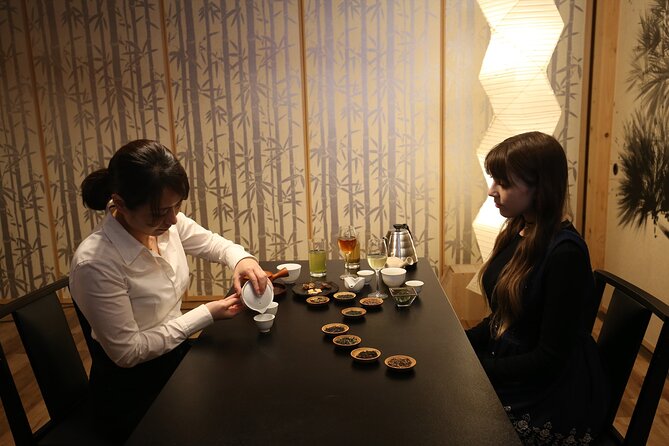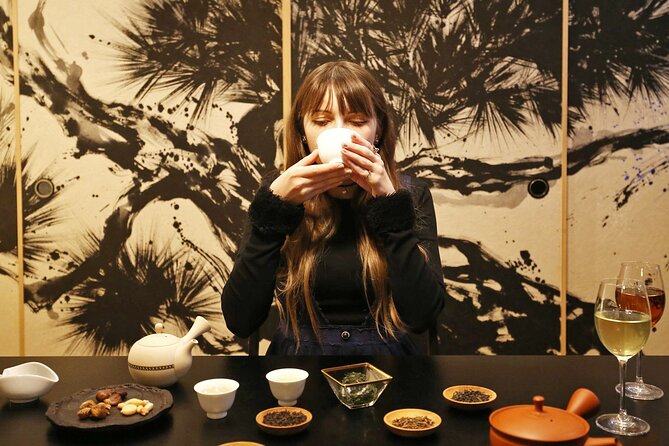7 Kinds of Japanese Tea Tasting Experience
While some may seek the comforting familiarity of a steaming cup of green tea, others are drawn to the vibrant allure of matcha’s intense flavors.
Each of the seven kinds of Japanese tea offers a distinct experience, inviting enthusiasts to savor the complexities of taste, aroma, and tradition.
As the journey unfolds, nuances of Sencha, Genmaicha, Hojicha, Gyokuro, and Kukicha reveal the artistry and cultural significance behind every sip.
With a blend of history, craftsmanship, and sensory delight, this exploration promises a captivating glimpse into the world of Japanese tea that is both enriching and enlightening.
Key Points

- Green tea offers diverse flavors and health benefits through customizable brewing methods.
- Matcha provides a unique blend of antioxidants and flavors for mindfulness and culinary versatility.
- Specialty tea blends like Genmaicha and Hojicha offer distinct, harmonious flavor profiles for varied tasting experiences.
- Unique varieties like Kukicha bring nutty, delicate tastes with potential wellness benefits for a unique tea journey.
Green Tea

Green tea, a beloved beverage with a rich cultural history, is renowned for its health benefits and distinctive flavor profile. Packed with antioxidants, green tea is known to boost metabolism, improve brain function, and lower the risk of various diseases.
Its different brewing methods, such as steeping loose leaves in hot water or using tea bags, allow for customization of flavor intensity. The benefits of green tea extend beyond just a tasty drink, as it offers calming effects due to its amino acid content.
Some enthusiasts prefer the traditional Japanese method of brewing green tea, where the leaves are infused with hot water in a teapot and then poured into cups. Experimenting with brewing times and water temperatures can further enhance the tea’s flavor profile.
Matcha

With a vibrant green color and a unique earthy flavor, Matcha is a finely ground powdered green tea that has gained popularity for its health benefits and versatility in culinary applications.
-
Matcha ceremony: A traditional Japanese ritual that involves the preparation and consumption of Matcha with a focus on mindfulness and respect.
-
Health benefits: Rich in antioxidants, vitamins, and minerals, Matcha is known to boost metabolism, improve concentration, and promote overall well-being.
-
Matcha latte: A modern twist on Matcha, combining the tea with steamed milk for a creamy and frothy beverage.
-
Culinary uses: Matcha is used in a variety of dishes, from desserts like Matcha ice cream to savory dishes for added flavor and color.
-
Unique flavor profile: Matcha offers a balance of umami, sweetness, and a slight bitterness, creating a complex taste experience.
Sencha
Known for its vibrant color and distinctive flavor profile, Sencha is a popular Japanese green tea variety enjoyed for its refreshing taste and numerous health benefits.
When tasting Sencha, it’s essential to pay attention to the brewing temperature, which should ideally be around 70-80°C to bring out the tea’s flavors without turning it bitter. The leaves are typically steeped for 1-2 minutes to achieve the perfect balance.
Sencha is rich in antioxidants and is believed to boost metabolism, aid in weight loss, and promote heart health. Regular consumption of Sencha may also help in reducing the risk of certain cancers and improving brain function.
With its grassy notes and delicate sweetness, Sencha offers a delightful tea tasting experience that’s both invigorating and beneficial to health.
Genmaicha

Characterized by its unique blend of green tea leaves and roasted brown rice, Genmaicha offers a delightful and toasty flavor profile that sets it apart from traditional green teas. This Japanese tea is a favorite among tea enthusiasts for its distinctive taste and aroma.
When exploring Genmaicha, one may encounter:
- Roasted rice: The roasted brown rice in Genmaicha adds a nutty and savory element to the tea.
- Tea ceremony: Genmaicha is sometimes used in traditional Japanese tea ceremonies, highlighting its cultural significance.
- Balanced flavors: The combination of green tea and roasted rice creates a harmonious balance of flavors.
- Toasty aroma: Genmaicha’s toasty aroma is soothing and comforting during tea sessions.
- Versatile pairing: Its mild flavor makes Genmaicha a versatile tea that pairs well with various dishes.
Hojicha
Genmaicha’s toasty aroma and balanced flavors pave the way for an exploration of Hojicha, a roasted green tea with a distinctive taste profile.
Hojicha undergoes a unique roasting process where the tea leaves are carefully roasted at high temperatures, resulting in a reddish-brown infusion and a nutty, caramel-like flavor. This roasting method gives Hojicha a smooth, rich taste with a soothing quality that sets it apart from other green teas.
Along With its delicious taste, Hojicha offers various health benefits. The roasting process reduces the tea’s caffeine content, making it a great choice for those looking to enjoy a flavorful tea without a significant caffeine boost. On top of that, Hojicha is rich in antioxidants, which can help support overall well-being.
Gyokuro
One of the most prized and sought-after varieties of Japanese green tea is Gyokuro, known for its vibrant emerald color and rich umami flavor. Gyokuro cultivation involves shading the tea bushes from direct sunlight for several weeks before harvesting, which enhances the amino acids and chlorophyll content, resulting in its distinctive taste.
When tasting Gyokuro, it’s essential to pay attention to the following techniques:
- Lower Temperature: Brew at a lower temperature to fully extract the delicate flavors.
- Multiple Steeps: Gyokuro can be steeped multiple times, revealing different layers of flavor.
- Covered Teacup: Using a covered teacup helps concentrate the aroma for a more immersive experience.
- Sipping Sound: Listen for the sound of the tea as you sip, indicating its quality.
- Appreciate Aroma: Take time to appreciate the sweet, grassy aroma before tasting.
Kukicha
Shifting from the prized Gyokuro tea, the discussion now turns to Kukicha, a unique Japanese green tea with a distinct flavor profile derived from its blend of stems, stalks, and twigs. Kukicha, also known as ‘twig tea,’ offers a delicate taste with a slightly nutty and creamy undertone.
To brew Kukicha effectively, steep 1 to 1.5 teaspoons of the tea leaves in hot water (about 175°F) for 1-2 minutes. This method allows the tea to release its subtle flavors without becoming bitter.
Along With its delightful taste, Kukicha also boasts various health benefits, including high antioxidant content, potential stress-reducing properties, and aiding digestion. Incorporating Kukicha into your tea routine can provide a soothing and refreshing experience while promoting wellness.
Common questions
Are There Any Age Restrictions for Participating in the Japanese Tea Tasting Experience?
Age restrictions vary depending on the activity. Each experience has specific guidelines. Booking requirements typically include age details. Visitors are advised to check the description for age limits and any accompanying rules to ensure a smooth participation process.
Is There a Minimum Number of Participants Required for Booking a Tasting Session?
For private sessions, a minimum group size may be required depending on availability and scheduling. It’s essential to check with the provider for specific details on booking requirements to secure a spot.
Can Participants Bring Their Own Tea Sets or Accessories to the Tasting Event?
Participants are encouraged to adhere to traditional tea etiquette. Bringing personal tasting accessories, like tea sets, is often permitted. However, it’s advisable to check with the organizer in advance to ensure compatibility with the event.
Are There Any Special Rituals or Traditions Associated With Japanese Tea Tasting That Participants Should Be Aware Of?
When participating in a Japanese tea ceremony, attendees should observe traditional etiquette and customs. Respectful behavior, such as bowing, silence during the ceremony, and accepting tea with both hands, honors the rich cultural significance of this ritual.
Is There a Dress Code or Any Specific Attire Recommended for the Tea Tasting Experience?
When attending a Japanese tea tasting, there is no specific dress code, but guests are encouraged to dress respectfully. Tea etiquette plays a vital role in Japanese culture, reflecting its deep-rooted cultural significance and traditions.
Last Words
Set out on a sensory journey through the world of Japanese tea with a tasting experience that will tantalize your taste buds and enlighten your senses.
From the refreshing notes of green tea to the bold flavors of matcha, each cup offers a unique glimpse into the rich cultural heritage of Japan.
Whether you’re a tea enthusiast or a curious beginner, exploring the diverse range of Japanese teas will surely leave you enchanted and inspired.
Cheers to the art of tea tasting!